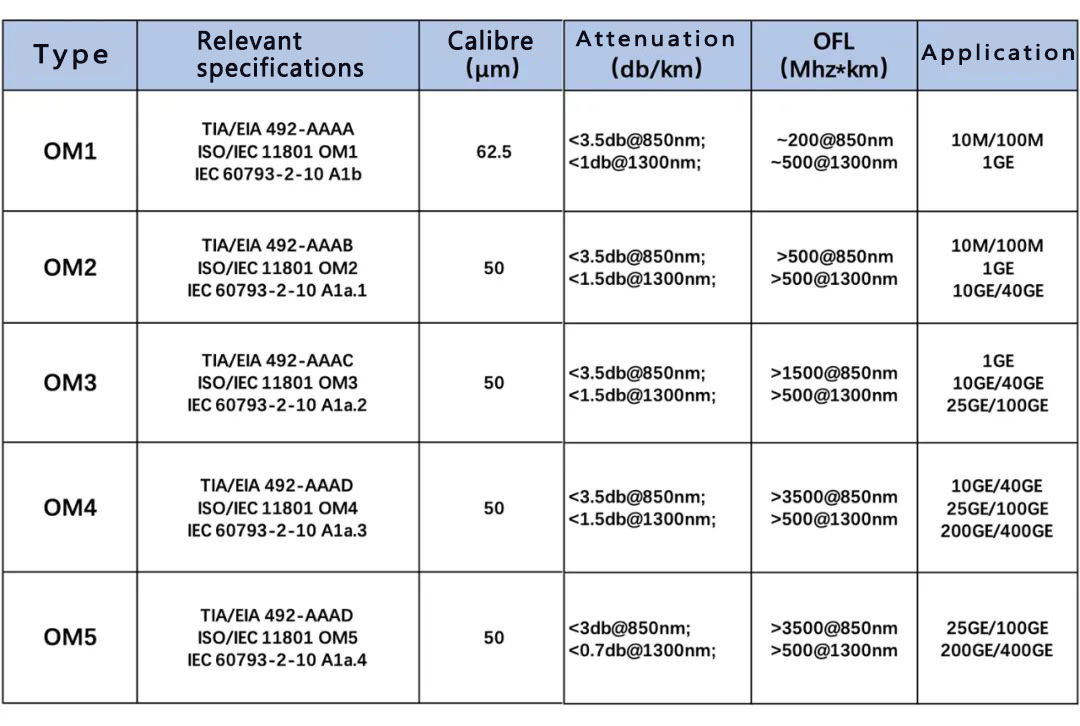

 Industry Dynamic +
Industry Dynamic +  2023.11.07
2023.11.07Optical fibres are generally divided into single-mode fibres and multi-mode fibres, and this time we will mainly start with multi-mode fibres. Multimode fibre allows many different modes of transmission within it when transmitting signals, and the transmission distance is limited due to the effect of mode dispersion brought about by the transmission of multiple modes. Let's start directly with the OM series of multimode fibres.
Since we are talking about OM1/2/3/4/5, let's first talk about its creation. There are many standards for multimode optical fibre, specifically the multimode optical fibre standard defined by the TIA organisation and later adopted by the ISO/IEC organisation.
>>> Recommended Reading What are the models of multimode fibre? A Beginner's Guide
"OM" - optical mode, is the standard by which multimode fibres indicate the grade of the fibre. Different grades transmit with different bandwidths, maximum distances, etc.

Let's start with a comparison of OM1/2/3/4.
OM5, as a new type of broadband fibre, we will start the analysis separately.
OM1
Refers to 850/1300nm full injection bandwidth in 200/500MHz.km above the 50um or 62.5um core diameter multimode fibre.
OM2
Refers to 850/1300nm full injection bandwidth in 500/500MHz.km above the 50um or 62.5um core diameter multimode fibre.
OM3
It is 850nm laser-optimised 50um core diameter multimode fibre, and the fibre transmission distance can reach 300m in 10Gb/s Ethernet using 850nm VCSEL.
OM4
It is the upgraded version of OM3 multimode fibre, and the fibre transmission distance can reach 550m.
OM1 and OM2
OM1 and OM2 are based on the LED (Light Emitting Diode) method as the basic light source in terms of standard and design.
OM3 and OM4
OM3 and OM4 are optimised on the basis of OM2, making them also suitable for transmission with LD (Laser Diode) as the light source. Compared with OM1 and OM2, OM3 has a higher transmission rate and bandwidth, so it is called optimised multimode fibre or 10 Gigabit multimode fibre.
OM1
The core diameter and numerical aperture are larger, with stronger light collection capacity and bending resistance.
OM2
Core diameter and numerical aperture are smaller, effectively reducing the mode dispersion of the multimode fibre, so that the bandwidth increases significantly, and the production cost is also reduced by 1/3.
OM3
The use of flame retardant jacket prevents the spread of flame, prevents the emission of smoke, acidic gases and toxic gases, etc., and meets the needs of 10 Gb/s transmission rate.
【OM4】.
Developed for VSCEL laser transmission, the effective bandwidth is more than double that of OM3.
OM1 and OM2
OM1 and OM2 have been widely deployed in applications inside buildings for many years, supporting Ethernet path transmission with a maximum value of 1Gb.
OM3 and OM4
OM3 and OM4 cables are typically used in data centre cabling environments, supporting 10G and even 40/100G high-speed Ethernet transmission.
After talking about how they compare to each other.
Let's move into a separate field and introduce OM5.
OM5 fibre is known as broadband multimode fibre patch cable.
It's a laser-optimised multimode fibre that's
with bandwidth characteristics specified specifically for WDM.
This new approach to fibre classification is designed to support a wide range of "short" wavelengths between 850nm and 950nm, which when aggregated are suitable for high bandwidth applications. OM3 and OM4 are designed to support a single wavelength of 850nm.
Less Fibre Support, Higher Bandwidth Applications
The OM5 fibre patchcord operates at 850/1300nm and can support at least four wavelengths, whereas the OM3 and OM4 typically operate at 850nm and 1300nm, meaning that the traditional OM1, OM2, OM3, and OM4 multimode fibres have only a single channel, whereas the OM5 has four channels, which is a four-fold increase in transmission capacity.
Combining short-wave wavelength-division multiplexing (SWDM) and parallel transmission technologies, OM5 requires only eight cores of wideband multimode fibre (WBMMF) to support 200/400G Ethernet applications, which greatly reduces the number of fibre cores and lowers the cabling cost of the network to a large extent.
Longer Transmission Distance
The transmission distance of OM5 fibre is longer than that of OM3 and OM4. OM4 fibre is designed to support a length of at least 100m with a 100G-SWDM4 transceiver. But OM5 fibre can support up to 150m length with the same transceiver.
Lower Fibre Loss
The attenuation of OM5 broadband multimode cables has been reduced to 3.0 dB/km from 3.5 dB/km in the previous OM3 and OM4 cables, with the added requirement of increased bandwidth at 953nm.
Full compatibility with OM3 and OM4
OM5 has the same fibre size as OM3 and OM4, which means that it is fully compatible with OM3 and OM4, and no changes are required to apply OM5 to existing cabling.
OM5 fibre is more scalable and flexible, supporting higher speed networks with fewer multimode fibre cores at a much lower cost and power consumption than singlemode fibre.
Subscribe to the newsletter
for all the latest updates.
2-5# Building, Tongfuyu Industrial Zone, Aiqun Road, Shiyan Street, Baoan District, Shenzhen. China
